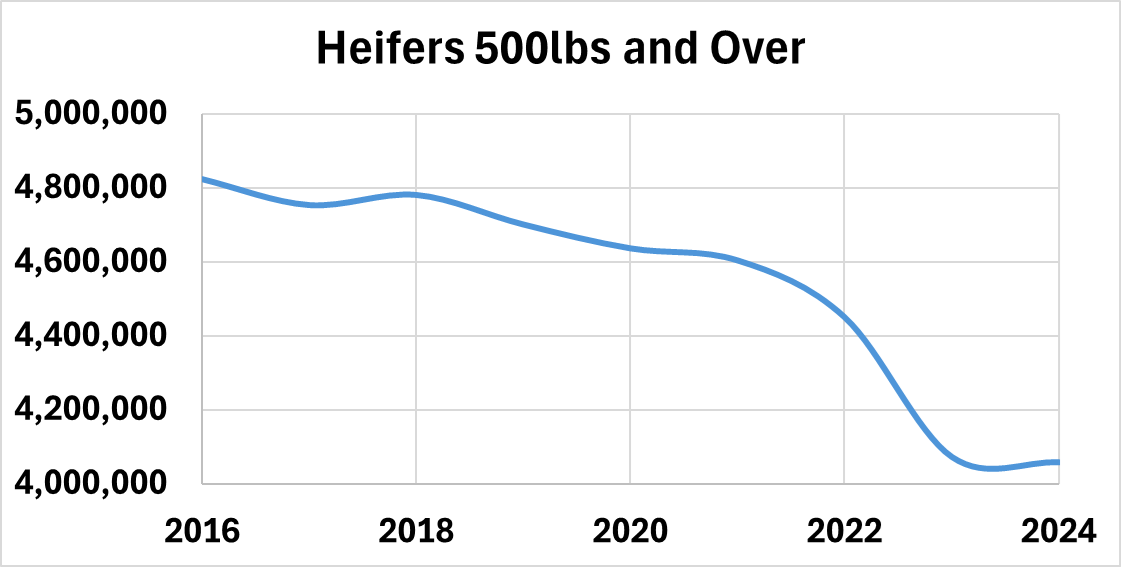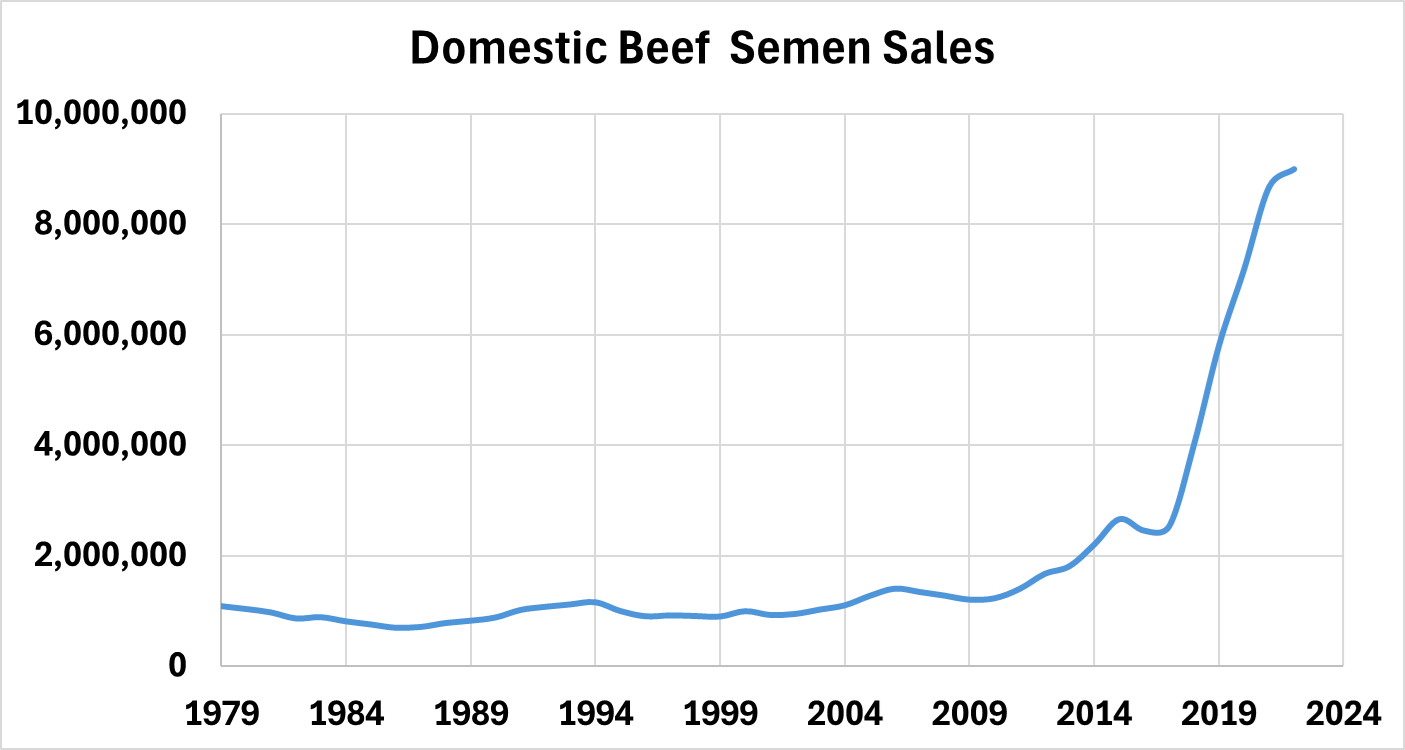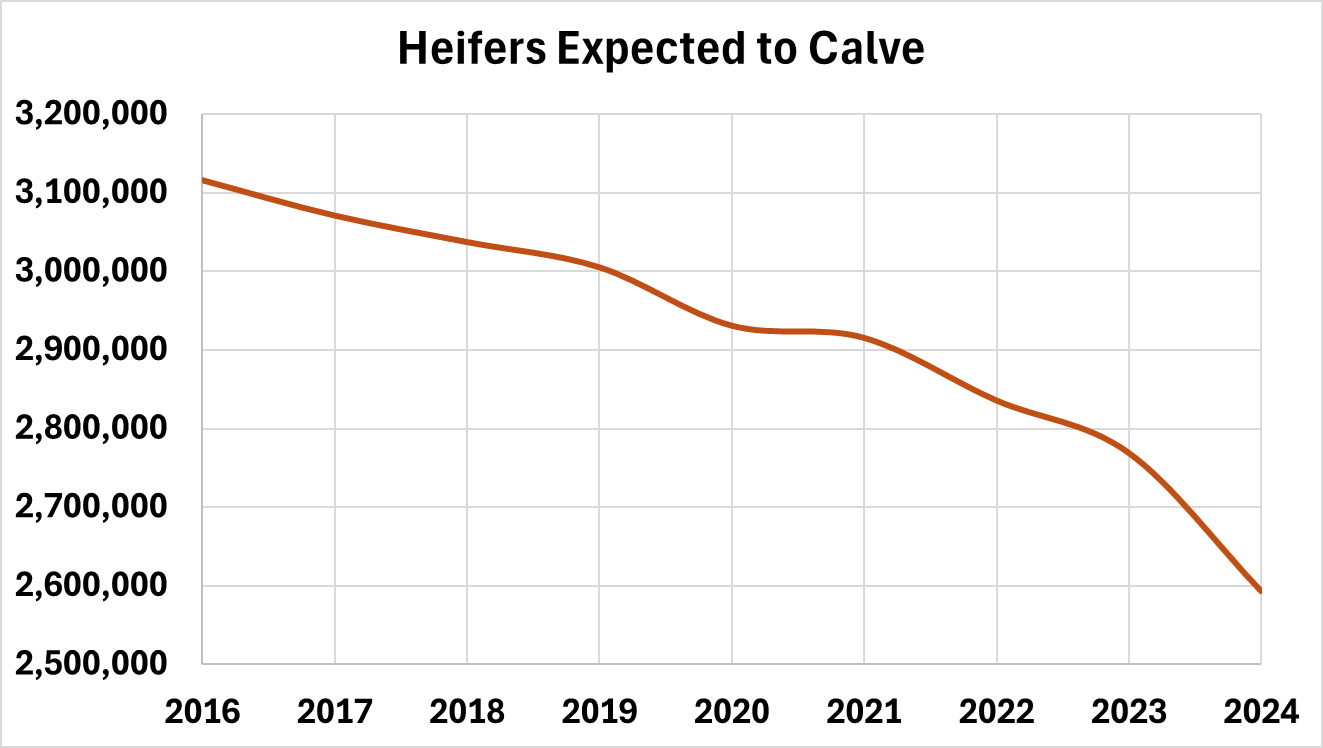The dairy industry is experiencing something that it has not experienced for several years: Dairy heifers are in short supply. In fact, this is the smallest heifer inventory that the industry has faced in 20 years. In its biannual cattle report, released recently, the USDA estimated that there are 4.059 million dairy heifers in the U.S. This is only a 0.35% drop from the estimated dairy heifer inventory of 4.073 million in 2023. However, heifer inventory has been declining for six consecutive years (Figure 1) and has declined about 15% over that time.

Adapted from USDA National Agricultural Statistics Service (NASS) data. Accessed January 31, 2024.
Several factors have played a pivotal role in this shift. Raising heifers is costly, with no return on investment until the heifer reaches the lactating herd. Farms have battled elevated feed costs and low milk prices, as well as increased labor costs and shortages, causing many farms to raise fewer heifers. Other factors include the use of genomics and sexed semen. Over the past few years, some farms have made the decision that it is economically favorable to purchase replacement heifers from another source instead of raising them.
One of the biggest drivers of fewer heifers has been the implementation of beef semen on dairies. Over the past six years, beef semen sales have more than doubled (Figure 2). During this time, dairies have been receiving a premium for beef × dairy calves. Now, with beef cattle inventory numbers hitting lows that have not been seen since the 1950s, high crossbred calf prices are driving even more dairies to utilize beef semen. The low beef-cattle inventory has also caused dairy heifers to end up in feedlots. The USDA recently reported that the number of dairy heifers expected to calve and enter the milking herd in 2024 has declined. There are 2.59 million head of heifers expected to calve, which is a 7% reduction compared to the 2.77 million head that were projected to calve at the beginning of last year (Figure 3). The low beef-cattle inventory and the limited number of dairy replacements available have driven cattle prices through the roof. Purchasing dairy replacement heifers and/or raising extra heifers is no longer economically feasible. Because of the limited number of dairy heifers available and the cost of purchasing replacements, it is crucial to make informed culling decisions to ensure that you have an adequate supply of replacements for your farm.

Adapted from National Association of Animal Breeders (NAAB) data. Accessed January 31, 2024.
Figure 3.

Adapted from USDA NASS data. Accessed January 31, 2024.
Historically, dairies raised their own replacements. The number of replacements raised was equal to 90–110% of total cow number, or farms just chose to raise every heifer calf. However, these are dated strategies that are no longer economical and can drive cow culling rates higher. To determine the number of replacements needed for your farm, several factors — such as the current herd turnover rate, age at first calving, and number of current replacements on hand — should all be considered. The farm’s breeding program also plays a role, as do the farm’s herd size goals.
Even though prices are favorable, be mindful not to over-cull heifers or too many cows from the lactating herd, especially older cows. Currently the price of replacement heifers is higher than the cost of raising them. There are also limited replacements available, driving high-quality springers to be highly sought after. Because heifer inventory is limited, strive to raise high-quality heifers, but also know when a heifer isn’t a good fit for your farm.
Reasons a heifer may be culled from the farm include:
- Poor growth and development: This includes heifers that fail to meet growth targets.
- Chronic health issues: Many times, calves will recover from scours, but if intestinal issues persist, this may warrant culling. Or, if an animal is not responding to treatment for respiratory issues, the lung damage may be permanent and warrant culling.
- Genetics: Any heifers that possess inferior genetics may be culled.
- Infertility or reproductive disorders: Heifers tend not to have many reproductive disorders, so if a heifer struggles to become pregnant, she will most likely struggle to become pregnant later in life.
Culling rates for the lactating herd vary by dairy but will typically run 35% or below. If the records are available, it is important to look not only at the cull rate, but at what cows are culled for, and at which stage of lactation. Management and protocols may need to be evaluated if the involuntary cull rate is too high. This consists of cows leaving the herd due to mastitis, reproduction, lameness or injury.
Make wise culling decisions on the lactating herd. Don’t cull all the older cows. The average cow leaves the herd between the second and third lactations. It isn’t until the third lactation that the cow begins to have a positive economic impact, and lifetime profit is even more profound during the fourth and further lactations. Culling young cows results in the herd relying heavily on older cows to pay for the younger cows that leave the herd.
Heifer-rearing costs are high, there are a limited number of replacement heifers available, and the cost of springers is high; therefore, we must raise high-quality heifers as replacements and make mindful culling decisions along the way.
- Focus on the management of heifers beginning when they are young, and try to minimize health events so that young animals do not get set back.
- Achieve average daily gain necessary to reach growth goals during key life stages. Heifers that do not reach growth goals prior to calving will reach it during lactation, at the expense of production. For every pound of body weight that is short at calving, it will cost 8 pounds of milk, and the growth will be much slower after lactation.
- Calve heifers at the appropriate age. Immaturity at calving affects the whole productive life, not only the first lactation. First-lactation animals typically produce approximately 85%, and second lactation approximately 95%, of the milk production of mature cows, with mature cows being in their third or more lactations (Figure 4.). The first lactation sets the production ceiling for the whole herd. Lagging heifers bring the average of the herd down, and this carries over into the next lactation. Calving heifers too late can also leave them susceptible to metabolic diseases and decreased production.
Figure 4. Breakdown of production by lactation

Heifer inventory is limited, so it is crucial to make informed culling decisions that will help your farm achieve success. Work with your Hubbard Feeds representative and other members of your trusted team of professionals to set goals for your farm.
References:
Semen Sales | National Association of Animal Breeders (naab-css.org)
- Log in to post comments
